remove seats DODGE CHALLENGER 2020 Owners Manual
[x] Cancel search | Manufacturer: DODGE, Model Year: 2020, Model line: CHALLENGER, Model: DODGE CHALLENGER 2020Pages: 396, PDF Size: 16.64 MB
Page 35 of 396
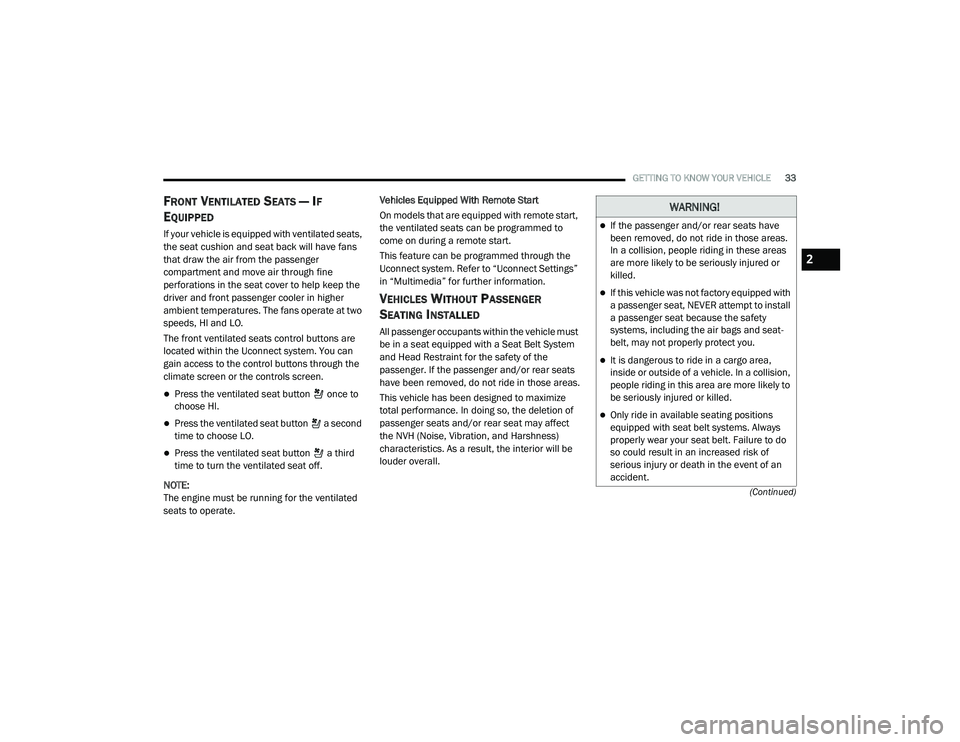
GETTING TO KNOW YOUR VEHICLE33
(Continued)
FRONT VENTILATED SEATS — IF
E
QUIPPED
If your vehicle is equipped with ventilated seats,
the seat cushion and seat back will have fans
that draw the air from the passenger
compartment and move air through fine
perforations in the seat cover to help keep the
driver and front passenger cooler in higher
ambient temperatures. The fans operate at two
speeds, HI and LO.
The front ventilated seats control buttons are
located within the Uconnect system. You can
gain access to the control buttons through the
climate screen or the controls screen.
Press the ventilated seat button once to
choose HI.
Press the ventilated seat button a second
time to choose LO.
Press the ventilated seat button a third
time to turn the ventilated seat off.
NOTE:
The engine must be running for the ventilated
seats to operate. Vehicles Equipped With Remote Start
On models that are equipped with remote start,
the ventilated seats can be programmed to
come on during a remote start.
This feature can be programmed through the
Uconnect system. Refer to “Uconnect Settings”
in “Multimedia” for further information.
VEHICLES WITHOUT PASSENGER
S
EATING INSTALLED
All passenger occupants within the vehicle must
be in a seat equipped with a Seat Belt System
and Head Restraint for the safety of the
passenger. If the passenger and/or rear seats
have been removed, do not ride in those areas.
This vehicle has been designed to maximize
total performance. In doing so, the deletion of
passenger seats and/or rear seat may affect
the NVH (Noise, Vibration, and Harshness)
characteristics. As a result, the interior will be
louder overall.
WARNING!
If the passenger and/or rear seats have
been removed, do not ride in those areas.
In a collision, people riding in these areas
are more likely to be seriously injured or
killed.
If this vehicle was not factory equipped with
a passenger seat, NEVER attempt to install
a passenger seat because the safety
systems, including the air bags and seat -
belt, may not properly protect you.
It is dangerous to ride in a cargo area,
inside or outside of a vehicle. In a collision,
people riding in this area are more likely to
be seriously injured or killed.
Only ride in available seating positions
equipped with seat belt systems. Always
properly wear your seat belt. Failure to do
so could result in an increased risk of
serious injury or death in the event of an
accident.
2
20_LA_OM_EN_USC_t.book Page 33
Page 36 of 396
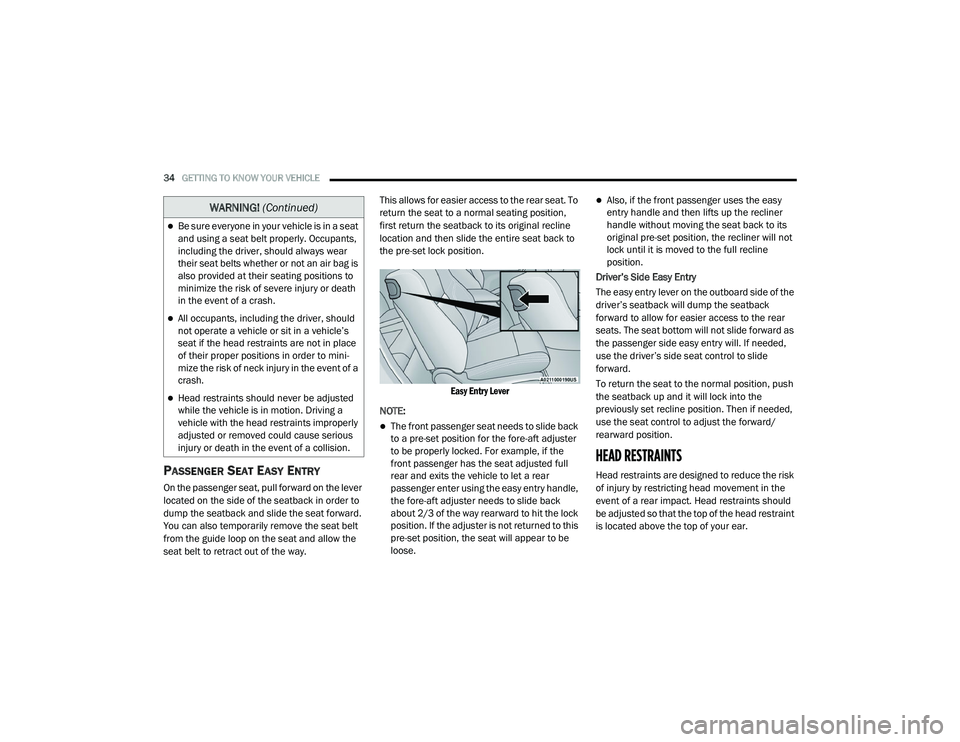
34GETTING TO KNOW YOUR VEHICLE
PASSENGER SEAT EASY ENTRY
On the passenger seat, pull forward on the lever
located on the side of the seatback in order to
dump the seatback and slide the seat forward.
You can also temporarily remove the seat belt
from the guide loop on the seat and allow the
seat belt to retract out of the way. This allows for easier access to the rear seat. To
return the seat to a normal seating position,
first return the seatback to its original recline
location and then slide the entire seat back to
the pre-set lock position.
Easy Entry Lever
NOTE:
The front passenger seat needs to slide back
to a pre-set position for the fore-aft adjuster
to be properly locked. For example, if the
front passenger has the seat adjusted full
rear and exits the vehicle to let a rear
passenger enter using the easy entry handle,
the fore-aft adjuster needs to slide back
about 2/3 of the way rearward to hit the lock
position. If the adjuster is not returned to this
pre-set position, the seat will appear to be
loose.
Also, if the front passenger uses the easy
entry handle and then lifts up the recliner
handle without moving the seat back to its
original pre-set position, the recliner will not
lock until it is moved to the full recline
position.
Driver’s Side Easy Entry
The easy entry lever on the outboard side of the
driver’s seatback will dump the seatback
forward to allow for easier access to the rear
seats. The seat bottom will not slide forward as
the passenger side easy entry will. If needed,
use the driver’s side seat control to slide
forward.
To return the seat to the normal position, push
the seatback up and it will lock into the
previously set recline position. Then if needed,
use the seat control to adjust the forward/
rearward position.
HEAD RESTRAINTS
Head restraints are designed to reduce the risk
of injury by restricting head movement in the
event of a rear impact. Head restraints should
be adjusted so that the top of the head restraint
is located above the top of your ear.
Be sure everyone in your vehicle is in a seat
and using a seat belt properly. Occupants,
including the driver, should always wear
their seat belts whether or not an air bag is
also provided at their seating positions to
minimize the risk of severe injury or death
in the event of a crash.
All occupants, including the driver, should
not operate a vehicle or sit in a vehicle’s
seat if the head restraints are not in place
of their proper positions in order to mini -
mize the risk of neck injury in the event of a
crash.
Head restraints should never be adjusted
while the vehicle is in motion. Driving a
vehicle with the head restraints improperly
adjusted or removed could cause serious
injury or death in the event of a collision.
WARNING! (Continued)
20_LA_OM_EN_USC_t.book Page 34
Page 37 of 396
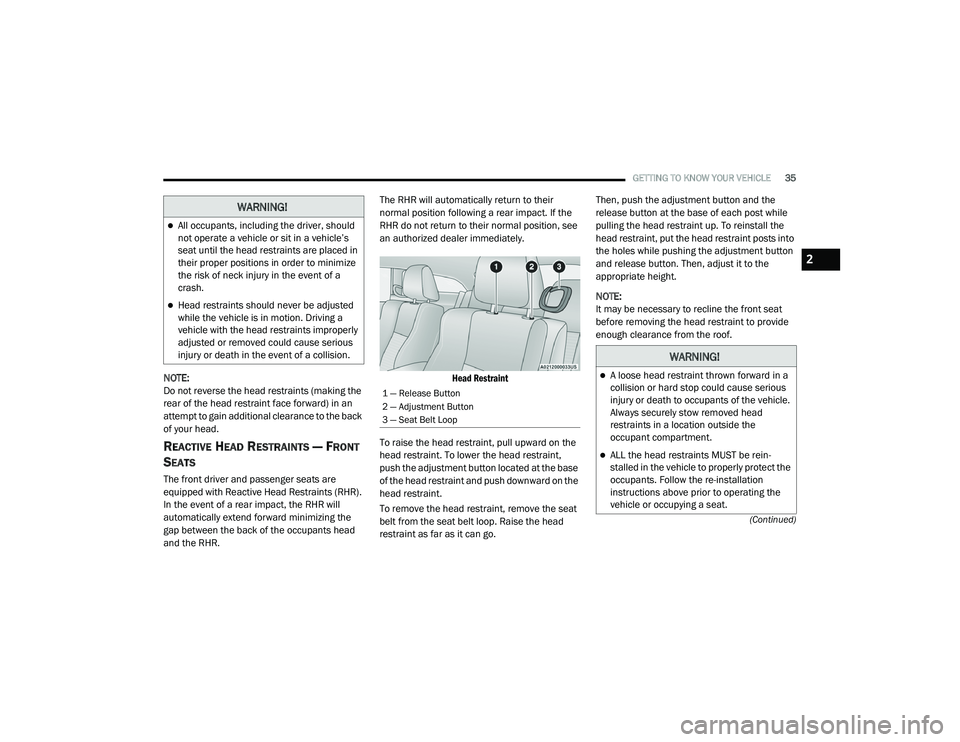
GETTING TO KNOW YOUR VEHICLE35
(Continued)
NOTE:
Do not reverse the head restraints (making the
rear of the head restraint face forward) in an
attempt to gain additional clearance to the back
of your head.
REACTIVE HEAD RESTRAINTS — FRONT
S
EATS
The front driver and passenger seats are
equipped with Reactive Head Restraints (RHR).
In the event of a rear impact, the RHR will
automatically extend forward minimizing the
gap between the back of the occupants head
and the RHR. The RHR will automatically return to their
normal position following a rear impact. If the
RHR do not return to their normal position, see
an authorized dealer immediately.
Head Restraint
To raise the head restraint, pull upward on the
head restraint. To lower the head restraint,
push the adjustment button located at the base
of the head restraint and push downward on the
head restraint.
To remove the head restraint, remove the seat
belt from the seat belt loop. Raise the head
restraint as far as it can go. Then, push the adjustment button and the
release button at the base of each post while
pulling the head restraint up. To reinstall the
head restraint, put the head restraint posts into
the holes while pushing the adjustment button
and release button. Then, adjust it to the
appropriate height.
NOTE:
It may be necessary to recline the front seat
before removing the head restraint to provide
enough clearance from the roof.
WARNING!
All occupants, including the driver, should
not operate a vehicle or sit in a vehicle’s
seat until the head restraints are placed in
their proper positions in order to minimize
the risk of neck injury in the event of a
crash.
Head restraints should never be adjusted
while the vehicle is in motion. Driving a
vehicle with the head restraints improperly
adjusted or removed could cause serious
injury or death in the event of a collision.
1 — Release Button
2 — Adjustment Button
3 — Seat Belt Loop
WARNING!
A loose head restraint thrown forward in a
collision or hard stop could cause serious
injury or death to occupants of the vehicle.
Always securely stow removed head
restraints in a location outside the
occupant compartment.
ALL the head restraints MUST be rein
-
stalled in the vehicle to properly protect the
occupants. Follow the re-installation
instructions above prior to operating the
vehicle or occupying a seat.
2
20_LA_OM_EN_USC_t.book Page 35
Page 38 of 396
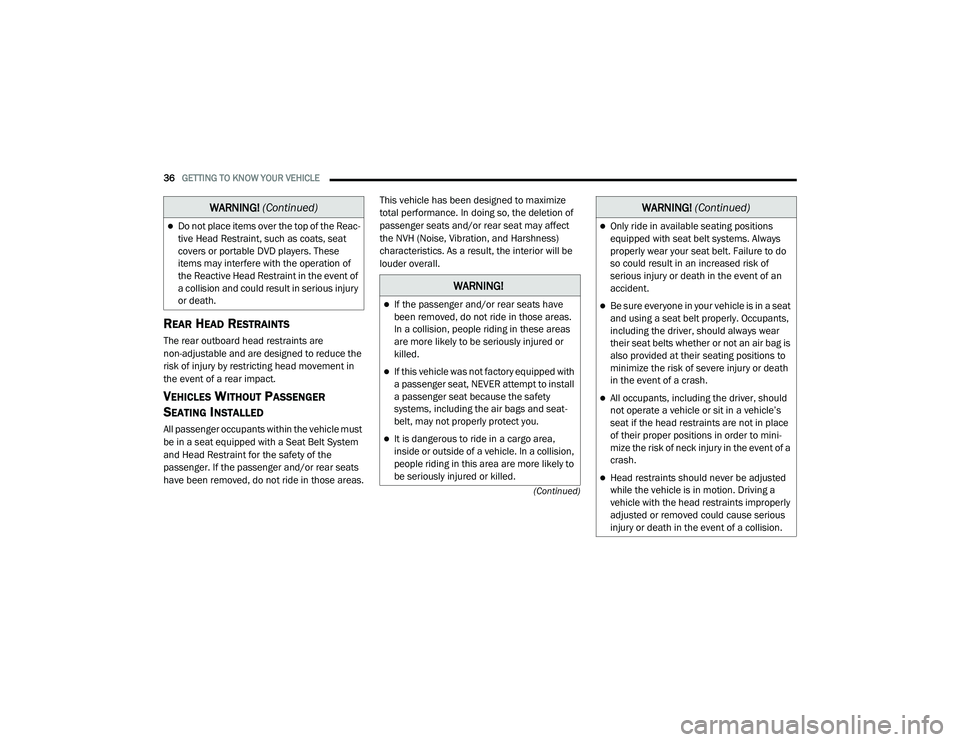
36GETTING TO KNOW YOUR VEHICLE
(Continued)
REAR HEAD RESTRAINTS
The rear outboard head restraints are
non-adjustable and are designed to reduce the
risk of injury by restricting head movement in
the event of a rear impact.
VEHICLES WITHOUT PASSENGER
S
EATING INSTALLED
All passenger occupants within the vehicle must
be in a seat equipped with a Seat Belt System
and Head Restraint for the safety of the
passenger. If the passenger and/or rear seats
have been removed, do not ride in those areas. This vehicle has been designed to maximize
total performance. In doing so, the deletion of
passenger seats and/or rear seat may affect
the NVH (Noise, Vibration, and Harshness)
characteristics. As a result, the interior will be
louder overall.
Do not place items over the top of the Reac
-
tive Head Restraint, such as coats, seat
covers or portable DVD players. These
items may interfere with the operation of
the Reactive Head Restraint in the event of
a collision and could result in serious injury
or death.
WARNING! (Continued)
WARNING!
If the passenger and/or rear seats have
been removed, do not ride in those areas.
In a collision, people riding in these areas
are more likely to be seriously injured or
killed.
If this vehicle was not factory equipped with
a passenger seat, NEVER attempt to install
a passenger seat because the safety
systems, including the air bags and seat -
belt, may not properly protect you.
It is dangerous to ride in a cargo area,
inside or outside of a vehicle. In a collision,
people riding in this area are more likely to
be seriously injured or killed.
Only ride in available seating positions
equipped with seat belt systems. Always
properly wear your seat belt. Failure to do
so could result in an increased risk of
serious injury or death in the event of an
accident.
Be sure everyone in your vehicle is in a seat
and using a seat belt properly. Occupants,
including the driver, should always wear
their seat belts whether or not an air bag is
also provided at their seating positions to
minimize the risk of severe injury or death
in the event of a crash.
All occupants, including the driver, should
not operate a vehicle or sit in a vehicle’s
seat if the head restraints are not in place
of their proper positions in order to mini -
mize the risk of neck injury in the event of a
crash.
Head restraints should never be adjusted
while the vehicle is in motion. Driving a
vehicle with the head restraints improperly
adjusted or removed could cause serious
injury or death in the event of a collision.
WARNING! (Continued)
20_LA_OM_EN_USC_t.book Page 36
Page 115 of 396
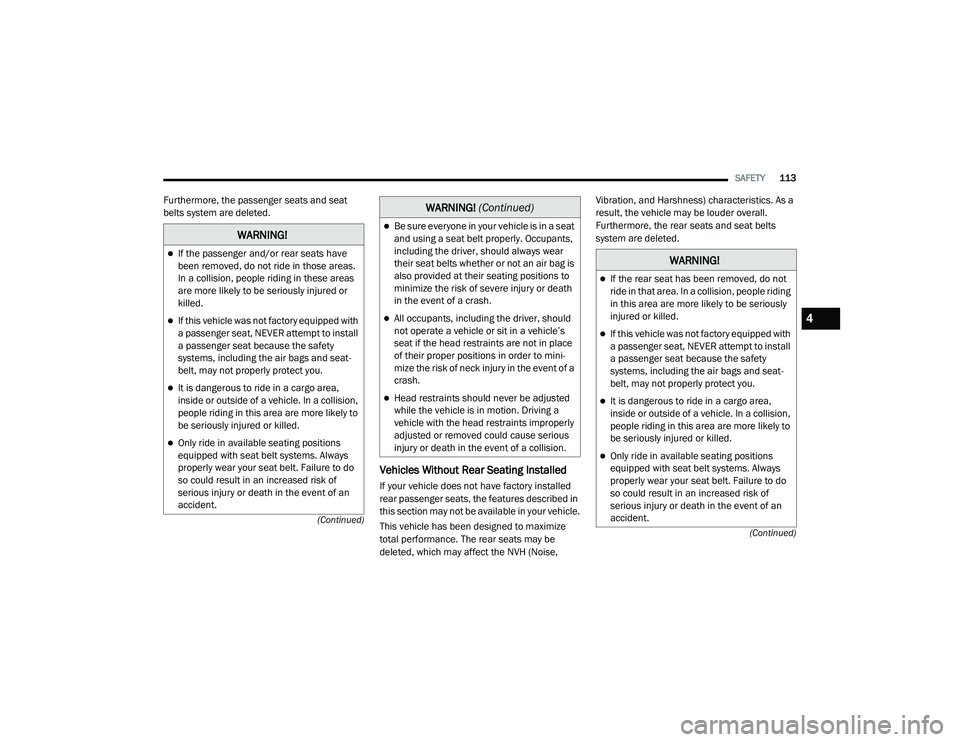
SAFETY113
(Continued)
(Continued)
Furthermore, the passenger seats and seat
belts system are deleted.
Vehicles Without Rear Seating Installed
If your vehicle does not have factory installed
rear passenger seats, the features described in
this section may not be available in your vehicle.
This vehicle has been designed to maximize
total performance. The rear seats may be
deleted, which may affect the NVH (Noise, Vibration, and Harshness) characteristics. As a
result, the vehicle may be louder overall.
Furthermore, the rear seats and seat belts
system are deleted.
WARNING!
If the passenger and/or rear seats have
been removed, do not ride in those areas.
In a collision, people riding in these areas
are more likely to be seriously injured or
killed.
If this vehicle was not factory equipped with
a passenger seat, NEVER attempt to install
a passenger seat because the safety
systems, including the air bags and seat
-
belt, may not properly protect you.
It is dangerous to ride in a cargo area,
inside or outside of a vehicle. In a collision,
people riding in this area are more likely to
be seriously injured or killed.
Only ride in available seating positions
equipped with seat belt systems. Always
properly wear your seat belt. Failure to do
so could result in an increased risk of
serious injury or death in the event of an
accident.
Be sure everyone in your vehicle is in a seat
and using a seat belt properly. Occupants,
including the driver, should always wear
their seat belts whether or not an air bag is
also provided at their seating positions to
minimize the risk of severe injury or death
in the event of a crash.
All occupants, including the driver, should
not operate a vehicle or sit in a vehicle’s
seat if the head restraints are not in place
of their proper positions in order to mini -
mize the risk of neck injury in the event of a
crash.
Head restraints should never be adjusted
while the vehicle is in motion. Driving a
vehicle with the head restraints improperly
adjusted or removed could cause serious
injury or death in the event of a collision.
WARNING! (Continued)
WARNING!
If the rear seat has been removed, do not
ride in that area. In a collision, people riding
in this area are more likely to be seriously
injured or killed.
If this vehicle was not factory equipped with
a passenger seat, NEVER attempt to install
a passenger seat because the safety
systems, including the air bags and seat -
belt, may not properly protect you.
It is dangerous to ride in a cargo area,
inside or outside of a vehicle. In a collision,
people riding in this area are more likely to
be seriously injured or killed.
Only ride in available seating positions
equipped with seat belt systems. Always
properly wear your seat belt. Failure to do
so could result in an increased risk of
serious injury or death in the event of an
accident.
4
20_LA_OM_EN_USC_t.book Page 113
Page 122 of 396
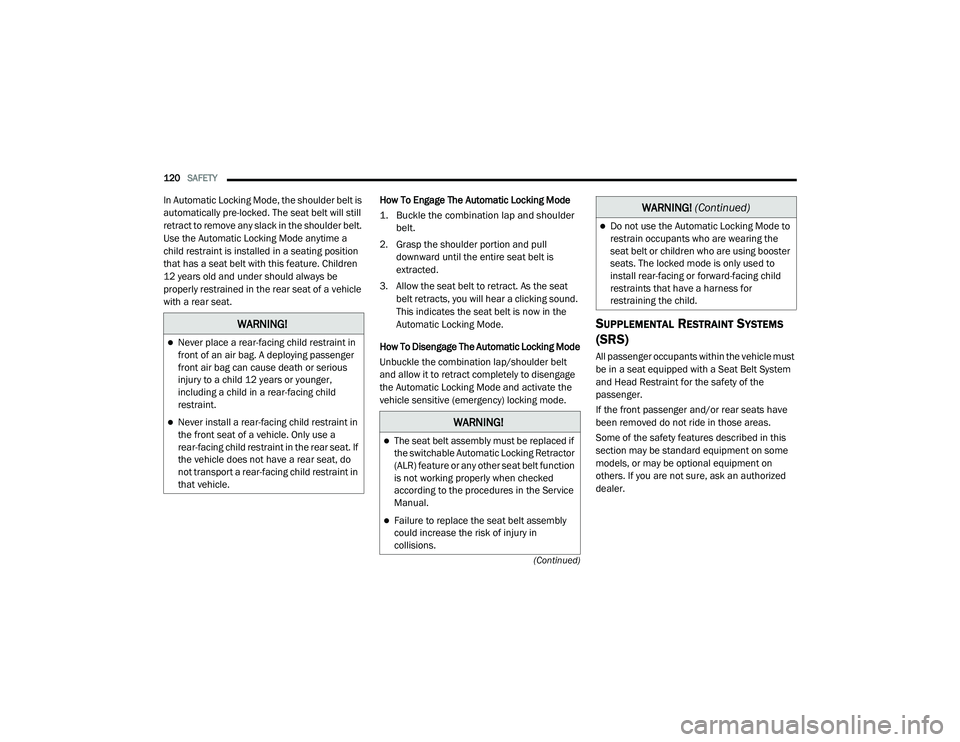
120SAFETY
(Continued)
In Automatic Locking Mode, the shoulder belt is
automatically pre-locked. The seat belt will still
retract to remove any slack in the shoulder belt.
Use the Automatic Locking Mode anytime a
child restraint is installed in a seating position
that has a seat belt with this feature. Children
12 years old and under should always be
properly restrained in the rear seat of a vehicle
with a rear seat.How To Engage The Automatic Locking Mode
1. Buckle the combination lap and shoulder
belt.
2. Grasp the shoulder portion and pull downward until the entire seat belt is
extracted.
3. Allow the seat belt to retract. As the seat belt retracts, you will hear a clicking sound.
This indicates the seat belt is now in the
Automatic Locking Mode.
How To Disengage The Automatic Locking Mode
Unbuckle the combination lap/shoulder belt
and allow it to retract completely to disengage
the Automatic Locking Mode and activate the
vehicle sensitive (emergency) locking mode.
SUPPLEMENTAL RESTRAINT SYSTEMS
(SRS)
All passenger occupants within the vehicle must
be in a seat equipped with a Seat Belt System
and Head Restraint for the safety of the
passenger.
If the front passenger and/or rear seats have
been removed do not ride in those areas.
Some of the safety features described in this
section may be standard equipment on some
models, or may be optional equipment on
others. If you are not sure, ask an authorized
dealer.
WARNING!
Never place a rear-facing child restraint in
front of an air bag. A deploying passenger
front air bag can cause death or serious
injury to a child 12 years or younger,
including a child in a rear-facing child
restraint.
Never install a rear-facing child restraint in
the front seat of a vehicle. Only use a
rear-facing child restraint in the rear seat. If
the vehicle does not have a rear seat, do
not transport a rear-facing child restraint in
that vehicle.WARNING!
The seat belt assembly must be replaced if
the switchable Automatic Locking Retractor
(ALR) feature or any other seat belt function
is not working properly when checked
according to the procedures in the Service
Manual.
Failure to replace the seat belt assembly
could increase the risk of injury in
collisions.
Do not use the Automatic Locking Mode to
restrain occupants who are wearing the
seat belt or children who are using booster
seats. The locked mode is only used to
install rear-facing or forward-facing child
restraints that have a harness for
restraining the child.
WARNING! (Continued)
20_LA_OM_EN_USC_t.book Page 120
Page 123 of 396
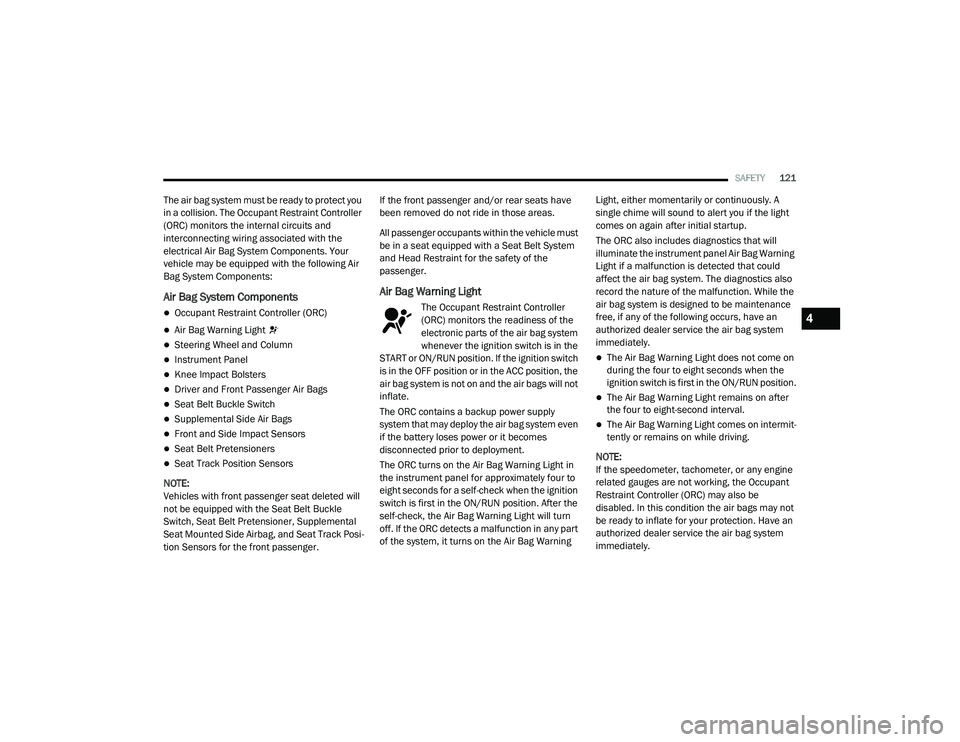
SAFETY121
The air bag system must be ready to protect you
in a collision. The Occupant Restraint Controller
(ORC) monitors the internal circuits and
interconnecting wiring associated with the
electrical Air Bag System Components. Your
vehicle may be equipped with the following Air
Bag System Components:
Air Bag System Components
Occupant Restraint Controller (ORC)
Air Bag Warning Light
Steering Wheel and Column
Instrument Panel
Knee Impact Bolsters
Driver and Front Passenger Air Bags
Seat Belt Buckle Switch
Supplemental Side Air Bags
Front and Side Impact Sensors
Seat Belt Pretensioners
Seat Track Position Sensors
NOTE:
Vehicles with front passenger seat deleted will
not be equipped with the Seat Belt Buckle
Switch, Seat Belt Pretensioner, Supplemental
Seat Mounted Side Airbag, and Seat Track Posi -
tion Sensors for the front passenger. If the front passenger and/or rear seats have
been removed do not ride in those areas.
All passenger occupants within the vehicle must
be in a seat equipped with a Seat Belt System
and Head Restraint for the safety of the
passenger.
Air Bag Warning Light
The Occupant Restraint Controller
(ORC) monitors the readiness of the
electronic parts of the air bag system
whenever the ignition switch is in the
START or ON/RUN position. If the ignition switch
is in the OFF position or in the ACC position, the
air bag system is not on and the air bags will not
inflate.
The ORC contains a backup power supply
system that may deploy the air bag system even
if the battery loses power or it becomes
disconnected prior to deployment.
The ORC turns on the Air Bag Warning Light in
the instrument panel for approximately four to
eight seconds for a self-check when the ignition
switch is first in the ON/RUN position. After the
self-check, the Air Bag Warning Light will turn
off. If the ORC detects a malfunction in any part
of the system, it turns on the Air Bag Warning Light, either momentarily or continuously. A
single chime will sound to alert you if the light
comes on again after initial startup.
The ORC also includes diagnostics that will
illuminate the instrument panel Air Bag Warning
Light if a malfunction is detected that could
affect the air bag system. The diagnostics also
record the nature of the malfunction. While the
air bag system is designed to be maintenance
free, if any of the following occurs, have an
authorized dealer service the air bag system
immediately.
The Air Bag Warning Light does not come on
during the four to eight seconds when the
ignition switch is first in the ON/RUN position.
The Air Bag Warning Light remains on after
the four to eight-second interval.
The Air Bag Warning Light comes on intermit
-
tently or remains on while driving.
NOTE:
If the speedometer, tachometer, or any engine
related gauges are not working, the Occupant
Restraint Controller (ORC) may also be
disabled. In this condition the air bags may not
be ready to inflate for your protection. Have an
authorized dealer service the air bag system
immediately.
4
20_LA_OM_EN_USC_t.book Page 121
Page 129 of 396
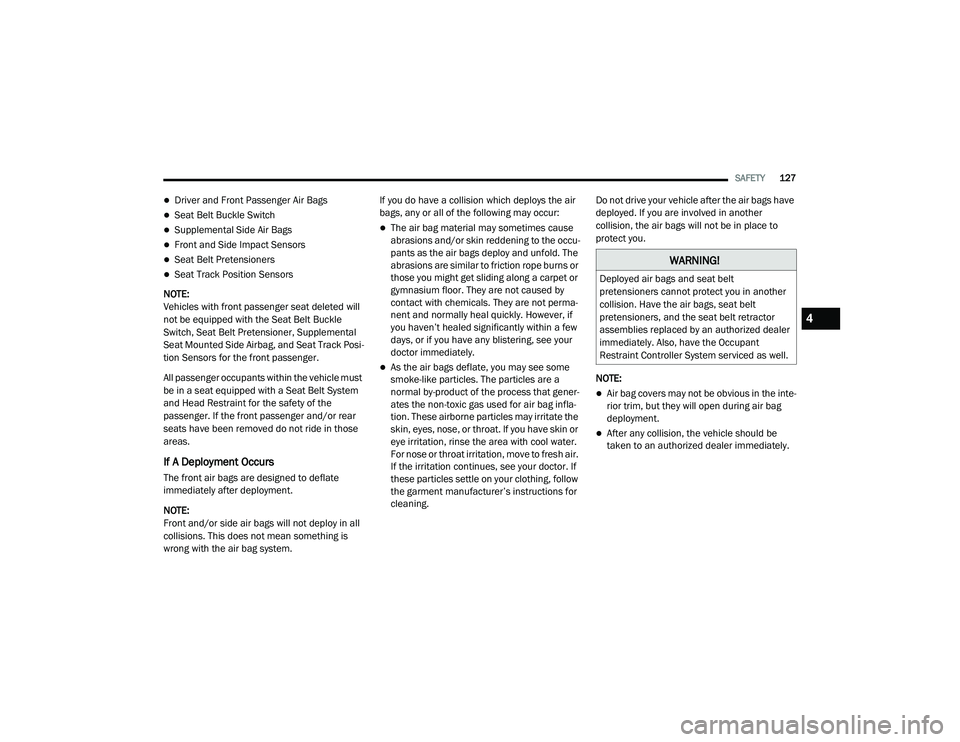
SAFETY127
Driver and Front Passenger Air Bags
Seat Belt Buckle Switch
Supplemental Side Air Bags
Front and Side Impact Sensors
Seat Belt Pretensioners
Seat Track Position Sensors
NOTE:
Vehicles with front passenger seat deleted will
not be equipped with the Seat Belt Buckle
Switch, Seat Belt Pretensioner, Supplemental
Seat Mounted Side Airbag, and Seat Track Posi -
tion Sensors for the front passenger.
All passenger occupants within the vehicle must
be in a seat equipped with a Seat Belt System
and Head Restraint for the safety of the
passenger. If the front passenger and/or rear
seats have been removed do not ride in those
areas.
If A Deployment Occurs
The front air bags are designed to deflate
immediately after deployment.
NOTE:
Front and/or side air bags will not deploy in all
collisions. This does not mean something is
wrong with the air bag system. If you do have a collision which deploys the air
bags, any or all of the following may occur:
The air bag material may sometimes cause
abrasions and/or skin reddening to the occu
-
pants as the air bags deploy and unfold. The
abrasions are similar to friction rope burns or
those you might get sliding along a carpet or
gymnasium floor. They are not caused by
contact with chemicals. They are not perma -
nent and normally heal quickly. However, if
you haven’t healed significantly within a few
days, or if you have any blistering, see your
doctor immediately.
As the air bags deflate, you may see some
smoke-like particles. The particles are a
normal by-product of the process that gener -
ates the non-toxic gas used for air bag infla -
tion. These airborne particles may irritate the
skin, eyes, nose, or throat. If you have skin or
eye irritation, rinse the area with cool water.
For nose or throat irritation, move to fresh air.
If the irritation continues, see your doctor. If
these particles settle on your clothing, follow
the garment manufacturer’s instructions for
cleaning. Do not drive your vehicle after the air bags have
deployed. If you are involved in another
collision, the air bags will not be in place to
protect you.
NOTE:
Air bag covers may not be obvious in the inte
-
rior trim, but they will open during air bag
deployment.
After any collision, the vehicle should be
taken to an authorized dealer immediately.
WARNING!
Deployed air bags and seat belt
pretensioners cannot protect you in another
collision. Have the air bags, seat belt
pretensioners, and the seat belt retractor
assemblies replaced by an authorized dealer
immediately. Also, have the Occupant
Restraint Controller System serviced as well.
4
20_LA_OM_EN_USC_t.book Page 127
Page 135 of 396
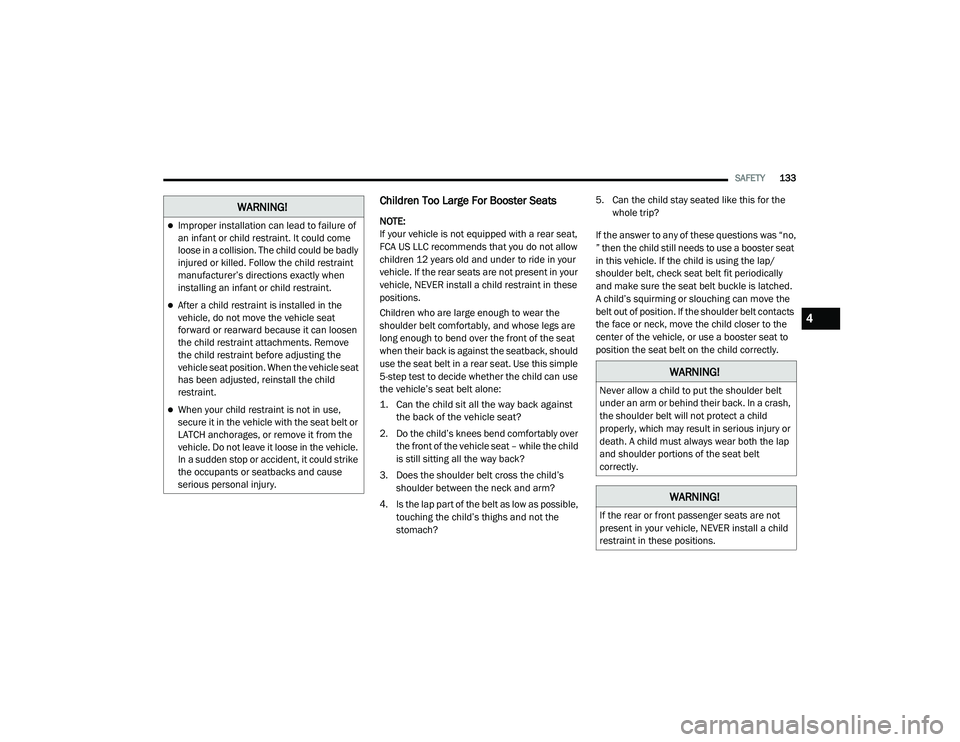
SAFETY133
Children Too Large For Booster Seats
NOTE:
If your vehicle is not equipped with a rear seat,
FCA US LLC recommends that you do not allow
children 12 years old and under to ride in your
vehicle. If the rear seats are not present in your
vehicle, NEVER install a child restraint in these
positions.
Children who are large enough to wear the
shoulder belt comfortably, and whose legs are
long enough to bend over the front of the seat
when their back is against the seatback, should
use the seat belt in a rear seat. Use this simple
5-step test to decide whether the child can use
the vehicle’s seat belt alone:
1. Can the child sit all the way back against
the back of the vehicle seat?
2. Do the child’s knees bend comfortably over the front of the vehicle seat – while the child
is still sitting all the way back?
3. Does the shoulder belt cross the child’s shoulder between the neck and arm?
4. Is the lap part of the belt as low as possible, touching the child’s thighs and not the
stomach? 5. Can the child stay seated like this for the
whole trip?
If the answer to any of these questions was “no,
” then the child still needs to use a booster seat
in this vehicle. If the child is using the lap/
shoulder belt, check seat belt fit periodically
and make sure the seat belt buckle is latched.
A child’s squirming or slouching can move the
belt out of position. If the shoulder belt contacts
the face or neck, move the child closer to the
center of the vehicle, or use a booster seat to
position the seat belt on the child correctly.
WARNING!
Improper installation can lead to failure of
an infant or child restraint. It could come
loose in a collision. The child could be badly
injured or killed. Follow the child restraint
manufacturer’s directions exactly when
installing an infant or child restraint.
After a child restraint is installed in the
vehicle, do not move the vehicle seat
forward or rearward because it can loosen
the child restraint attachments. Remove
the child restraint before adjusting the
vehicle seat position. When the vehicle seat
has been adjusted, reinstall the child
restraint.
When your child restraint is not in use,
secure it in the vehicle with the seat belt or
LATCH anchorages, or remove it from the
vehicle. Do not leave it loose in the vehicle.
In a sudden stop or accident, it could strike
the occupants or seatbacks and cause
serious personal injury.
WARNING!
Never allow a child to put the shoulder belt
under an arm or behind their back. In a crash,
the shoulder belt will not protect a child
properly, which may result in serious injury or
death. A child must always wear both the lap
and shoulder portions of the seat belt
correctly.
WARNING!
If the rear or front passenger seats are not
present in your vehicle, NEVER install a child
restraint in these positions.
4
20_LA_OM_EN_USC_t.book Page 133
Page 139 of 396

SAFETY137
Frequently Asked Questions About Installing Child Restraints With LATCH
What is the weight limit (child’s weight + weight
of the child restraint) for using the LATCH
anchorage system to attach the child restraint? 65 lbs (29.5 kg)Use the LATCH anchorage system until the
combined weight of the child and the child
restraint is 65 lbs (29.5 kg). Use the seat belt
and tether anchor instead of the LATCH system
once the combined weight is more than 65 lbs
(29.5 kg).
Can the LATCH anchorages and the seat belt be
used together to attach a rear-facing or
forward-facing child restraint? NoDo not use the seat belt when you use the
LATCH anchorage system to attach a rear-facing
or forward-facing child restraint.
Booster seats may be attached to the LATCH
anchorages if allowed by the booster seat
manufacturer. See your booster seat owner’s
manual for more information.
Can two child restraints be attached using a
common lower LATCH anchorage? NoNever “share” a LATCH anchorage with two or
more child restraints. If the center position does
not have dedicated LATCH lower anchorages,
use the seat belt to install a child seat in the
center position next to a child seat using the
LATCH anchorages in an outboard position.
Can the rear-facing child restraint touch the
back of the front passenger seat? YesThe child seat may touch the back of the front
passenger seat if the child restraint
manufacturer also allows contact. See your
child restraint owner’s manual for more
information.
Can the rear head restraints be removed? No
4
20_LA_OM_EN_USC_t.book Page 137